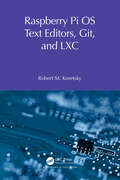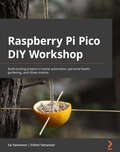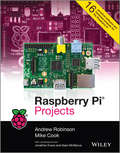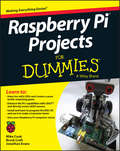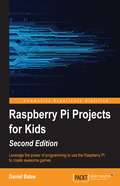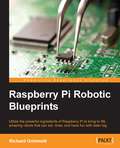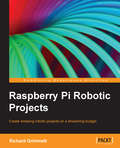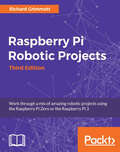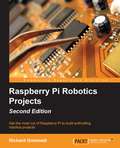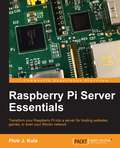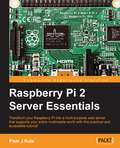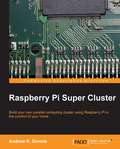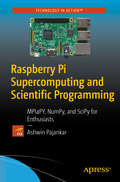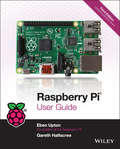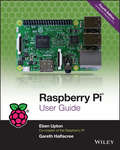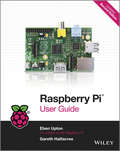- Table View
- List View
Raspberry Pi OS System Administration: Ancillary Topics (Raspberry Pi OS System Administration with systemd)
by Robert M KoretskyThe fourth volume in a new series exploring the basics of Raspberry Pi Operating System administration, this installment builds on the insights provided in Volumes 1, 2, and 3 to provide a compendium of easy-to-use and essential Raspberry Pi OS administration for the novice user, with specific focus on ancillary topics that can be used with the Raspberry Pi OS based upon upstream Debian Bookworm release, and the Raspberry Pi 5.The overriding idea behind system administration of a modern, 21st-century Linux system such as the Raspberry Pi OS is the use of systemd to ensure that the Linux kernel works efficiently and effectively to provide these three foundation stones of computer operation and management: computer system concurrency, virtualization, and secure persistence. This fourth volume includes full-chapter explications, with many examples, of the following: the Zettabyte File System (ZFS), the X Window System, the Wayland protocol, XWayland, the Wayfire window manager, XCB, Qt5, and GTK4 graphics, the Emacs text editor, and a basic introduction to important Raspberry Pi commands for the novice user. This book is aimed at students and practitioners looking to maximize their use of the Raspberry Pi OS. With plenty of practical examples, projects, and exercises, this volume can also be adopted in a more formal learning environment to supplement and extend the basic knowledge of a Linux operating system.
Raspberry Pi OS Text Editors, git, and LXC: A Practical Approach (Raspberry Pi OS System Administration with systemd)
by Robert M KoretskyThe third volume in a new series exploring the basics of Raspberry Pi Operating System administration, this installment builds on the insights from Volumes 1 and 2 to provide a compendium of easy-to-use and essential guidance for Raspberry Pi system administration for novice users, with specific focus on Text Editors, git/ GitHub, and LXC/LXD.The overriding idea behind system administration of a modern, 21st-century Linux system, such as the Raspberry Pi OS, is the use of systemd to ensure that the Linux kernel works efficiently and effectively to provide these three foundation stones of computer operation and management: computer system concurrency, virtualization, and secure persistence. This third volume includes a beginner’s compendium of essential text-based Linux commands, a complete tutorial on the most important Raspberry Pi OS Text Editors, a description of uses of the git command, and a thorough explication of container virtualization with LXC/LXD and Docker.This book is aimed at students and practitioners looking to maximize their use of the Raspberry Pi OS. With plenty of practical examples, projects, and exercises, this volume can also be adopted in a more formal learning environment to supplement and extend the basic knowledge of a Linux operating system.
Raspberry Pi Pico DIY Workshop: Build exciting projects in home automation, personal health, gardening, and citizen science
by Srihari Yamanoor Sai YamanoorTake your first steps with the Raspberry Pi Pico and take on exciting projects using CircuitPython, MicroPython, and PicoKey FeaturesMake the most of the Raspberry Pi Pico—a low-cost microcontroller that is primed for innovationWork with easy-to-follow examples and learn how to interface and program a Raspberry Pi PicoWork on fun projects, right from home automation to building a seven-segment display to tracking air qualityBook DescriptionThe Raspberry Pi Pico is the latest addition to the Raspberry Pi family of products. Introduced by the Raspberry Pi Foundation, based on their RP2040 chip, it is a tiny, fast microcontroller that packs enough punch to power an extensive range of applications. Raspberry Pi Pico DIY Workshop will help you get started with your own Pico and leverage its features to develop innovative products. This book begins with an introduction to the Raspberry Pi Pico, giving you a thorough understanding of the RP2040's peripherals and different development boards for the Pico designed and manufactured by various organizations. You'll explore add-on hardware and programming language options available for the Pico. Next, you'll focus on practical skills, starting with a simple LED blinking project and building up to a giant seven-segment display, while working with application examples such as citizen science displays, digital health, and robots. You'll also work on exciting projects around gardening, building a weather station, tracking air quality, hacking your personal health, and building a robot, along with discovering tips and tricks to give you the confidence needed to make the best use of RP2040. By the end of this Raspberry Pi book, you'll have built a solid foundation in product development using the RP2040, acquired a skillset crucial for embedded device development, and have a robot that you built yourself.What you will learnUnderstand the RP2040's peripherals and apply them in the real worldFind out about the programming languages that can be used to program the RP2040Delve into the applications of serial interfaces available on the PicoDiscover add-on hardware available for the RP2040Explore different development board variants for the Raspberry Pi PicoDiscover tips and tricks for seamless product development with the PicoWho this book is forThis book is for students, teachers, engineers, scientists, artists, and tech enthusiasts who want to develop embedded systems that drive cost-effective automation, IoT, robotics, medical devices, and art projects. If you consider yourself a maker and would like to learn how to use the Raspberry Pi Pico, then this book is for you. Familiarity with Python programming, MicroPython, CircuitPython, embedded hardware, and peripherals is helpful but not mandatory to get the most out of this book.
Raspberry Pi Projects
by Mike Cook Andrew RobinsonLearn to build software and hardware projects featuring the Raspberry Pi!Raspberry Pi represents a new generation of computers that encourages the user to play and to learn and this unique book is aimed at the beginner Raspberry Pi user who is eager to get started creating real-world projects. Taking you on a journey of creating 16 practical projects, this fun and informative resource introduces you to the skills you need to have in order to make the most of the Pi. The book begins with a quick look at how to get the Pi up and running and then encourages you to dive into the array of exciting software and hardware projects.Features projects that use Python, which is Raspberry Pi's programming language of choiceIncludes projects for creating an information center for e-mail, Twitter, Facebook, weather, train times, and moreShows you how to recreate Pong and Pacman or write Tic Tac ToeTeaches you how to use Raspberry Pi's general purpose input/output port in order to speak to external hardware devicesWalks you through setting up computer-controlled slot car racing, a swipe card door lock, disco lights, and moreRaspberry Pi Projects is an excellent way to dig deeper into the capabilities of the Pi and to have great fun while doing it.
Raspberry Pi Projects For Dummies
by Jonathan Evans Brock Craft Mike CookJoin the Raspberry revolution with these fun and easy Pi projects The Raspberry Pi has opened up a whole new world of innovation for everyone from hardware hackers and programmers to students, hobbyists, engineers, and beyond. Featuring a variety of hands-on projects, this easy-to-understand guide walks you through every step of the design process and will have you creating like a Raspberry Pi pro in no time. You'll learn how to prepare your workspace, assemble the necessary tools, work with test equipment, and find your way around the Raspberry Pi before moving on to a series of fun, lively projects that brings some power to your plain ol' Pi. Introduces Raspberry Pi basics and gives you a solid understanding of all the essentials you'll need to take on your first project Includes an array of fun and useful projects that show you how to do everything from creating a magic light wand to enhancing your designs with Lego sensors, installing and writing games for the RISC OS, building a transistor tester, and more Provides an easy, hands-on approach to learning more about electronics, programming, and interaction design for Makers and innovators of all ages Bring the power of Pi to your next cool creation with Raspberry Pi Projects For Dummies!
Raspberry Pi Projects for Kids
by Daniel BatesThis tutorial contains all-important information about how to use your Raspberry Pi to develop any application you like. It is broken down into several action-packed projects, each containing easy-to-follow steps, just to show you how easy and fun computer programming can be! If you are someone with a big imagination and would like to dive straight into the realm of technology and computers, then this is the book for you. With only a Raspberry Pi and no prior experience required, you will be shown how to translate your ideas into computer programs, creating any game, tool, or animation you can dream of.
Raspberry Pi Projects for Kids - Second Edition
by Daniel BatesThis book is for kids who wish to develop games and applications using the Raspberry Pi. No prior experience in programming is necessary; you need only a Raspberry Pi and the required peripherals.
Raspberry Pi Projects for Kids: Create an MP3 Player, Mod Minecraft, Hack Radio Waves, and More!
by Dan AldredLearn coding and electronics through 12 original and daring projects that hack wireless signals.The Raspberry Pi is an inexpensive, pocket-sized computer that will help you build and code your own hardware projects.Raspberry Pi Projects for Kids will show you how to harness the power of the Raspberry Pi to create 12 cool projects using simple code and common materials like a webcam, microphone, and LED lights. Step-by-step instructions and detailed diagrams guide you through each project.After a brief introduction to the Python programming language, you'll learn how to: • Create an LED night-light that turns itself on and off • Set up a Raspberry Pi camera to take selfies and videos • Set up a webcam to stream video to your cell phone • Manipulate environments in Minecraft • Hijack local radio waves to play your own songs and recordings • Configure Raspberry Pi to send texts to a cell phone • Track your family members' locations via wi-fi and Bluetooth • Create an MP3 player • Set up a camera to take motion-triggered photos of wildlife • Control the electronics in your home with your cell phone • Teach Raspberry Pi to read aloud posts from your Twitter feed • Play "Rock, Paper, Scissors" against Raspberry PiRaspberry Pi Projects for Kids will deliver hours of fun and endless inspiration!
Raspberry Pi Retail Applications: Transform Your Business with a Low-Cost Single-Board Computer
by Elaine Wu Dmitry MaslovIncrease productivity and lower the operating cost of your business by automating crucial business processes with the Raspberry Pi. After completing this book's projects you'll be able to determine the best way to quickly apply automation to existing systems and processes in your retail outlet with Raspberry Pi. You’ll start by composing ideas to transform your business, and then gain practical, accessible methods for executing them. Find real-world ways to implement tech solutions to accelerate the growth of your business, and navigate the ever-changing landscape of retail automation with this book. Then see what automation can and cannot do at the current level of technical progress for retail businesses. By comparing the efficiency of machines with manual labor, you’ll be able to assess how open-source hardware performs in lowering operating costs and identify business components that can be improved with automation. Raspberry Pi Retail Applications features projects that are easy to dive into and will function readily in your day-to-day business right now. What You'll LearnIdentify business components that can be improved with automation Combine the existing array of Raspberry Pi hardware options to build customized solutions Implement tech ideas in a practical retail environment to reduce cost and streamline your business processes Who This Book Is ForSmall and medium business owners or technology officers looking for solutions to increase efficiency, lower operating costs, and drive up profits for their retail companies with automation. Familiarity with open-source hardware and programming skills is helpful, but not necessary.
Raspberry Pi Retro Gaming: Build Consoles and Arcade Cabinets to Play Your Favorite Classic Games
by Mark Frauenfelder Ryan BatesLearn to configure a Raspberry Pi into multiple different devices capable of playing retro games. Beyond theory, this book focuses heavily on projects—such as making a console to attach to a TV or computer display and making a tabletop arcade machine. It also teaches you how to install and use the Kodi media center on your retro game player. tart with the big-picture of the Raspberry Pi retro-gaming landscape and the wide range of exciting project opportunities that exist. You'll then discover the various retro-gaming emulation platforms, such as RetroPie and Recalbox, and how to work with ROM files. This book even goes a step further and teaches you how to create game ROMs from your old cartridges! You’ll also study the types of game playing equipment people have made using Raspberry Pis and how to set up a Raspberry Pi with those devices. Retro-gaming enthusiasts are using the Pi to make a dizzying variety of game playing hardware. There are players that fit in an Altoids mint tin, players that look like classic systems, and players that let you choose from over 20,000 game titles. And there are emulators for every platform imaginable, and many models available online to download and make on a 3D printer or laser cutter. Raspberry Pi Retro Gaming includes everything you need to know about playing retro games on a Raspberry Pi and making cool machines that play thousands of retrogames.What You'll LearnUse Tinkercad to design your own cases Get your case 3D printed if you don’t have a 3D printer Design parts for laser cutting or jigsaw cutting Solder and use electronics components, batteries, and power suppliesSelect and set up different kinds of displaysWho This Book Is ForAnyone interested in playing retrocomputer games and making their own retro-game players.
Raspberry Pi Robotic Blueprints
by Richard GrimmettUtilize the powerful ingredients of Raspberry Pi to bring to life your amazing robots that can act, draw, and have fun with laser tagsAbout This BookLearn to implement a number of features offered by Raspberry Pi to build your own amazing robotsUnderstand how to add vision and voice to your robots.This fast-paced practical guide comprises a number of creative projects to take your Raspberry Pi knowledge to the next levelWho This Book Is ForThis all-encompassing guide was created for anyone who is interested in expanding their knowledge in applying the peripherals of Raspberry Pi. If you have a fancy for building complex-looking robots with simple, inexpensive, and readily available hardware, then this book is ideal for you. Prior understanding of Raspberry Pi with simple mechanical systems is recommended.What You Will LearnAdd sensors to your robot so that it can sense the world around itKnow everything there is to know about accessing motors and servos to provide movement to the robotic platformExplore the feature of adding vision to your robot so it can "see" the world around itRefine your robot with the skill of speech recognition so that it can receive commandsPolish your robot by adding speech output so it can communicate with the world around itMaximize the use of servos in Raspberry Pi to create a drawing robotStrengthen your robot by adding wireless communication skills so you can see what the robot is seeing and control it from a distanceBuild an unbelievable autonomous hexcopter controlled by Raspberry PiIn DetailThe Raspberry Pi is a series of credit card-sized single-board computers developed in the UK by the Raspberry Pi Foundation with the intention of promoting the teaching of basic computer science in schools. The Raspberry Pi is known as a tiny computer built on a single circuit board. It runs a Linux operating system, and has connection ports for various peripherals so that it can be hooked up to sensors, motors, cameras, and more. Raspberry Pi has been hugely popular among hardware hobbyists for various projects, including robotics.This book gives you an insight into implementing several creative projects using the peripherals provided by Raspberry Pi. To start, we'll walk through the basic robotics concepts that the world of Raspberry Pi offers us, implementing wireless communication to control your robot from a distance. Next, we demonstrate how to build a sensible and a visionary robot, maximizing the use of sensors and step controllers. After that, we focus on building a wheeled robot that can draw and play hockey. To finish with a bang, we'll build an autonomous hexcopter, that is, a flying robot controlled by Raspberry Pi.By the end of this book, you will be a maestro in applying an array of different technologies to create almost any imaginable robot.Style and approachThis book is an easy-to-follow, project-based guide that throws you directly into the action of creating almost any imaginable robot through blueprints. It is full of step by step instructions and screenshots to help you build amazing robots in no time at all.
Raspberry Pi Robotic Projects
by Richard GrimmettThis book is for enthusiasts who want to use Raspberry Pi to build complex robotics projects. However, some programming background is recommended. With the aid of the step-by-step instructions in this book, you can construct complex robotics projects that can move, talk, listen, see, swim, or fly. Raspberry Pi Robotic Projects is an easy-to-follow, step-by-step projects guide packed full of examples of actual robotics projects. Each topic is explained in detail to make it easy to replicate the projects described.
Raspberry Pi Robotic Projects - Third Edition
by Richard GrimmettWork through a mix of amazing robotic projects using the Raspberry Pi Zero or the Raspberry Pi 3 About This Book • Easy to follow instructions, yet the ones that help you build powerful robots, and exclusive coverage of mobile robots with the Pi Zero • Build robots that can run, swim and fly and the cutting-edge dimension of robotics that is possible with the Raspberry Pi Zero and Pi 3 • Interact with your projects wirelessly and make sci-fi possible, right in your home Who This Book Is For This book is for hobbyists and programmers who are excited about using the Raspberry Pi 3 and Raspberry Pi Zero. It is for those who are taking their first steps towards using these devices to control hardware and software and write simple programs that enable amazing projects. No programming experience is required, Just a little computer and mechanical aptitude and the desire to build some interesting projects. What You Will Learn • Control a variety of different DC motors • Add a USB webcam to see what your robot can see • Attach a projector to project information • Insert USB control hardware to control a complex robot with two legs • Include speech recognition so that your projects can receive commands • Add speech output to that the robot can communicate with the world around it • Include wireless communication so that you can see what the robot is seeing and control the robot from a distance In Detail This book will allow you to take full advantage of Raspberry Pi Zero and Raspberry Pi 3 by building both simple and complex robotic projects. The book takes a mission-critical approach to show you how to build amazing robots and helps you decide which board to use for which type of robot. The book puts a special emphasis on designing mobile (or movable) robots using the Raspberry Pi Zero. The projects will show inexpensive, yet powerful, ways to take full advantage. It will teach you how to program Raspberry Pi, control the movement of your robot, and add features to your robots. Style and approach This fun and practical tutorial contain step-by-step instructions to get you hands-on building inexpensive projects. It contains mission-critical chapters and everything you need to know to get started.
Raspberry Pi Robotics Essentials
by Richard GrimmettIf you are a programmer with an interest in building advanced robotics projects using inexpensive hardware and open source software, then this book is for you. Some experience with computer programming and implementing simple mechanical systems is required.
Raspberry Pi Robotics Projects - Second Edition
by Richard GrimmettThis book is for enthusiasts who want to use the Raspberry Pi to build complex robotics projects. With the aid of the step-by-step instructions in this book, you can construct complex robotics projects that can move, talk, listen, see, swim, or fly. No previous Raspberry Pi robotics experience is assumed, but even experts will find unexpected and interesting information in this invaluable guide.
Raspberry Pi Sensors
by Rushi GajjarThis book is perfect for hardware enthusiasts who want to develop amazing projects using Raspberry Pi. Some knowledge and experience working with Linux, C, and Python is a plus, but once you're set up to go, you'll be ready to push the creative capabilities of your Raspberry Pi even further.
Raspberry Pi Server Essentials
by Piotr J. KulaThis is an engaging, easy to follow guide for developing a wide range of server projects with Raspberry Pi This book is targeted towards all Raspberry Pi enthusiasts who are interested in exploring the potential of Pi as a server. Even if you have no prior experience with the Raspberry Pi, you can pick up this book and develop a wide range of projects.
Raspberry Pi Server Essentials
by Piotr J. KulaThis is an engaging, easy to follow guide for developing a wide range of server projects with Raspberry Pi This book is targeted towards all Raspberry Pi enthusiasts who are interested in exploring the potential of Pi as a server. Even if you have no prior experience with the Raspberry Pi, you can pick up this book and develop a wide range of projects.
Raspberry Pi Super Cluster
by Andrew K. DennisThis book follows a step-by-step, tutorial-based approach which will teach you how to develop your own super cluster using Raspberry Pi computers quickly and efficiently.Raspberry Pi Super Cluster is an introductory guide for those interested in experimenting with parallel computing at home. Aimed at Raspberry Pi enthusiasts, this book is a primer for getting your first cluster up and running. Basic knowledge of C or Java would be helpful but no prior knowledge of parallel computing is necessary.
Raspberry Pi Supercomputing and Scientific Programming
by Ashwin PajankarBuild an inexpensive cluster of multiple Raspberry Pi computers and install all the required libraries to write parallel and scientific programs in Python 3. This book covers setting up your Raspberry Pis, installing the necessary software, and making a cluster of multiple Pis. Once the cluster is built, its power has to be exploited by means of programs to run on it. So, Raspberry Pi Supercomputing and Scientific Programming teaches you to code the cluster with the MPI4PY library of Python 3. Along the way, you will learn the concepts of the Message Passing Interface (MPI) standards and will explore the fundamentals of parallel programming on your inexpensive cluster. This will make this book a great starting point for supercomputing enthusiasts who want to get started with parallel programming. The book finishes with details of symbolic mathematics and scientific and numerical programming in Python, using SymPi, SciPy, NumPy, and Matplotlib. You'll see how to process signals and images, carry out calculations using linear algebra, and visualize your results, all using Python code. With the power of a Raspberry Pi supercomputer at your fingertips, data-intensive scientific programming becomes a reality at home. What You Will Learn Discover the essentials of supercomputing Build a low-cost cluster of Raspberry Pis at home Harness the power of parallel programming and the Message Passing Interface (MPI) Use your Raspberry Pi for symbolic, numerical, and scientific programming Who This Book Is For Python 3 developers who seek the knowledge of parallel programming, Raspberry Pi enthusiasts, researchers, and the scientific Python community.
Raspberry Pi User Guide
by Gareth Halfacree Eben UptonMake the most out of the world's first truly compact computerIt's the size of a credit card, it can be charged like a smartphone, it runs on open-source Linux, and it holds the promise of bringing programming and playing to millions at low cost. And now you can learn how to use this amazing computer from its co-creator, Eben Upton, in Raspberry Pi User Guide. Cowritten with Gareth Halfacree, this guide gets you up and running on Raspberry Pi, whether you're an educator, hacker, hobbyist, or kid. Learn how to connect your Pi to other hardware, install software, write basic programs, and set it up to run robots, multimedia centers, and more.Gets you up and running on Raspberry Pi, a high-tech computer the size of a credit card Helps educators teach students how to program Covers connecting Raspberry Pi to other hardware, such as monitors and keyboards, how to install software, and how to configure Raspberry Pi Shows you how to set up Raspberry Pi as a simple productivity computer, write basic programs in Python, connect to servos and sensors, and drive a robot or multimedia center Adults, kids, and devoted hardware hackers, now that you've got a Raspberry Pi, get the very most out of it with Raspberry Pi User Guide.
Raspberry Pi User Guide
by Gareth Halfacree Eben UptonMake the most out of the world’s first truly compact computer It's the size of a credit card, it can be charged like a smartphone, it runs on open-source Linux, and it holds the promise of bringing programming and playing to millions at low cost. And now you can learn how to use this amazing computer from its co-creator, Eben Upton, in Raspberry Pi User Guide. Cowritten with Gareth Halfacree, this guide gets you up and running on Raspberry Pi, whether you're an educator, hacker, hobbyist, or kid. Learn how to connect your Pi to other hardware, install software, write basic programs, and set it up to run robots, multimedia centers, and more. Gets you up and running on Raspberry Pi, a high-tech computer the size of a credit card Helps educators teach students how to program Covers connecting Raspberry Pi to other hardware, such as monitors and keyboards, how to install software, and how to configure Raspberry Pi Shows you how to set up Raspberry Pi as a simple productivity computer, write basic programs in Python, connect to servos and sensors, and drive a robot or multimedia center Adults, kids, and devoted hardware hackers, now that you've got a Raspberry Pi, get the very most out of it with Raspberry Pi User Guide.
Raspberry Pi User Guide
by Gareth Halfacree Eben UptonLearn the Raspberry Pi 3 from the experts! Raspberry Pi User Guide, 4th Edition is the "unofficial official" guide to everything Raspberry Pi 3. Written by the Pi's creator and a leading Pi guru, this book goes straight to the source to bring you the ultimate Raspberry Pi 3 manual. This new fourth edition has been updated to cover the Raspberry Pi 3 board and software, with detailed discussion on its wide array of configurations, languages, and applications. You'll learn how to take full advantage of the mighty Pi's full capabilities, and then expand those capabilities even more with add-on technologies. You'll write productivity and multimedia programs, and learn flexible programming languages that allow you to shape your Raspberry Pi into whatever you want it to be. If you're ready to jump right in, this book gets you started with clear, step-by-step instruction from software installation to system customization. The Raspberry Pi's tremendous popularity has spawned an entire industry of add-ons, parts, hacks, ideas, and inventions. The movement is growing, and pushing the boundaries of possibility along with it—are you ready to be a part of it? This book is your ideal companion for claiming your piece of the Pi. Get all set up with software, and connect to other devices Understand Linux System Admin nomenclature and conventions Write your own programs using Python and Scratch Extend the Pi's capabilities with add-ons like Wi-Fi dongles, a touch screen, and more The credit-card sized Raspberry Pi has become a global phenomenon. Created by the Raspberry Pi Foundation to get kids interested in programming, this tiny computer kick-started a movement of tinkerers, thinkers, experimenters, and inventors. Where will your Raspberry Pi 3 take you? The Raspberry Pi User Guide, 3rd Edition is your ultimate roadmap to discovery.
Raspberry Pi User Guide
by Gareth Halfacree Eben UptonThe essential guide to getting started with the Raspberry Pi ® The Raspberry Pi has been a success beyond the dream of its creators. Their goal, to encourage a new generation of computer programmers who understand how computers work, is well under way. Raspberry Pi User Guide 2e is the newest edition of the runaway bestseller written by the Pi’s co-creator, Eben Upton, and tech writer Gareth Halfacree. It contains everything you need to know to get the Pi up and running, including how to: Connect a keyboard, mouse, monitor and other peripherals Install software and configure your Raspberry Pi Master basic Linux system administration Set up your Raspberry Pi as a productivity machine, multimedia centre, or web server Write programmes in Scratch and Python Use the GPIO port and add-on boards to connect your Raspberry Pi for use in electronics projects Updated to cover the release of the Camera Board, the introduction of the Pi Store, NOOBS and much more, Raspberry Pi User Guide 2nd edition is the perfect companion for getting the most out of the computing phenomenon, the Raspberry Pi. Eben Upton is the co-creator of the Raspberry Pi board and the founder of the Raspberry Pi Foundation. Gareth Halfacree is a freelance technology journalist, open source advocate and erstwhile sysadmin.
Raspberry Pi Zero Cookbook
by Edward SnajderOver 80 practical and interesting recipes that explore the plethora of functionalities and opportunities available with Raspberry Pi Zero About This Book • Deep dive into the components of the small yet powerful Raspberry Pi Zero • Get into grips with integrating various hardware, programming, and networking concepts with the so-called “cheapest computer” • Explore the functionalities of this $5 chip through practical recipes Who This Book Is For This book is for programmers and hobbyists who are eager to dive deep into the Raspberry Pi Zero. If you have basic or zero knowledge of the Raspberry Pi Zero, or if you looking for examples of ways to utilize the Raspberry Pi's GPIO interface, then this book is ideal for you. Basic knowledge of Python will be beneficial, and experience with circuitry and electronics will be needed for the later chapters in the book. What You Will Learn • Set up your Raspberry Pi Zero with the operating system, networking, and different interfaces • Get a hands-on introduction to Linux, Python, and shell scripts with the Raspberry Pi Zero • Become a master at driving GPIOs and controlling relays, motors, transistors, buzzers, audio, read switches, and interrupts with the Raspberry Pi Zero • Control GPIOs using the web interface and Node.js • Connect displays, LED matrixes, analog sensors, and digital sensors • Hack the Ethernet on the Raspberry Pi Zero • Make your Raspberry Pi Zero an IoT-based sensor node and remotely monitor your data In Detail The Raspberry Pi Zero, one of the most inexpensive, fully-functional computers available, is a powerful and revolutionary product developed by the Raspberry Pi Foundation. The Raspberry Pi Zero opens up a new world for the makers out there. This book will give you expertise with the Raspberry Pi Zero, providing all the necessary recipes that will get you up and running. In this book, you will learn how to prepare your own circuits rather than buying the expensive add–ons available in the market. We start by showing you how to set up and manage the Pi Zero and then move on to configuring the hardware, running it with Linux, and programming it with Python scripts. Later, we integrate the Raspberry Pi Zero with sensors, motors, and other hardware. You will also get hands-on with interesting projects in media centers, IoT, and more. Style and approach This recipe-based book will ensure you gain an intermediate-level knowledge of the Raspberry Pi Zero. This book contains comprehensive illustrations with specific schematics for each circuit diagram.

